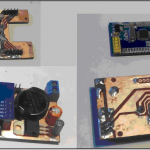
Recently, the Arduino software and hardware complex, which is designed to develop various interesting electronic structures, has become very popular. The designs are made by connecting the Arduino baseboard with additional necessary modules. On the Arduino baseboard there is a microcontroller, the firmware for which is written in a special development environment for Arduino using, as a rule, ready-made libraries for one or another module.
One of the modules – W5500 – is intended for the manufacture of electronic structures that will be connected to the Internet. In this case, most often, it means remote control of its structure. For example, it could be a smart home, a robot, and the like. The most trivial project (except for Hello world) is the remote activation of LEDs via a web browser (Fig. 1). If instead of the LEDs connect the transistor switches and relays, you can switch more powerful loads. Thus, in essence, the program (firmware) of this design is a web server that processes http requests from a remote user.
For more detail, go to https://super-geek-news.github.io/articles/414211/index.html


COMMENTS